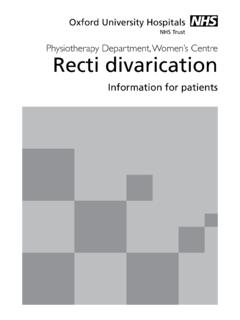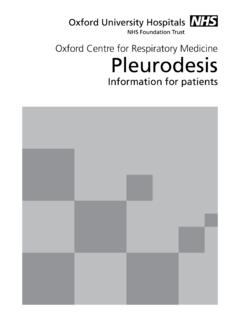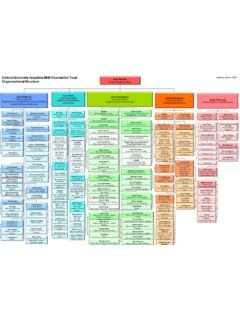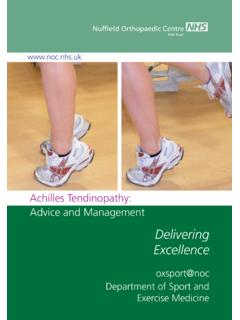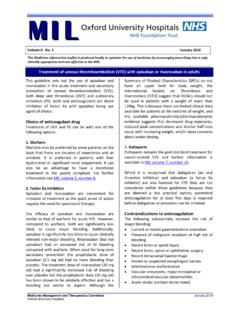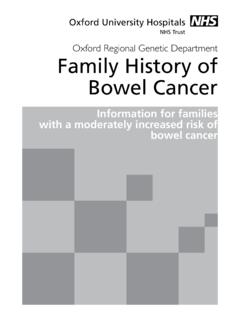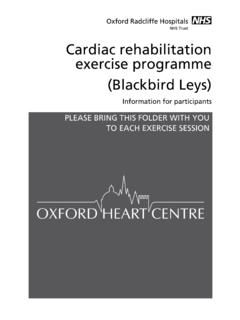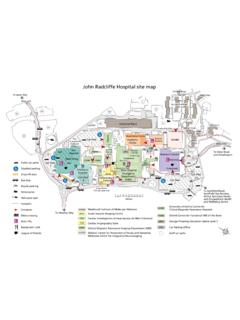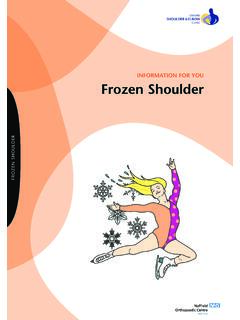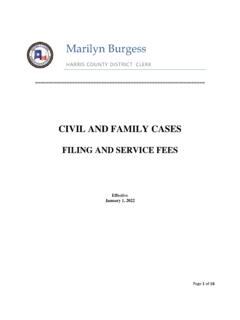Transcription of Hand & Plastics Physiotherapy Department Carpal Tunnel ...
1 Oxford University HospitalsNHS TrustHand & Plastics Physiotherapy DepartmentCarpal Tunnel SyndromeInformation for patientspage 2page 3 What is the Carpal Tunnel ?The Carpal Tunnel is made up of the bones in your wrist and a ligament which runs across the base of your palm. Several tendons and your median nerve run through the Tunnel to supply movement and sensation to your fingers. What causes Carpal Tunnel Syndrome?Symptoms occur when the nerve becomes pinched by pressure within the Tunnel . The reason is usually unknown, but possible causes can include: swelling of the lining of the tendons, joint dislocation, fractures or arthritis. Fluid retention during pregnancy can also sometimes cause swelling in the Tunnel . Symptoms are made worse by keeping the wrist bent for long periods of time. What are the symptoms?
2 Symptoms include numbness, tingling and/or pain in the arm, hand and/or fingers of the affected side. The symptoms are more often felt during the night, but may be noticed during the day when the wrist is bent for long periods of time. You may have noticed a weaker grip, or clumsiness when using your hand. In severe cases sensation may be permanently lost, and the muscles at the base of the thumb may reduce in clinician may do a test such as tapping along the line of the nerve or bending your wrist to see if your symptoms are brought on. You may also be sent for nerve conduction studies to give an accurate measure of the degree of pressure that is affecting the 4 What is the treatment?You may be given a splint to wear at night to prevent you from bending your wrist and compressing the nerve. Your therapist may advise you on how you position your hand when using it for prolonged activities at work or may give you some gentle exercises to do.
3 Anti-inflammatory medication taken orally or injected into the Carpal Tunnel may also relieve symptoms. When symptoms are severe or do not improve with the above, surgery may be needed to make more room for the nerve. A Carpal Tunnel Release (CTR) is a simple procedure involving releasing the ligament that forms the top of the Tunnel on the palm side of the hand, therefore easing the pressure on the nerve. What are the risks with CTR surgery?As with any surgery, you may be left with persistent pain, and/or stiffness following the operation, although normal use/exercise will make this less likely. There is also some risk of infection, or damage to nerves or blood vessels around the area. Please discuss this with your doctor if you would like more information. Is there anything I should avoid?The only action you should avoid for the first 4 weeks is excessive weight-bearing through the heel of your hand pushing up from a chair and heavy gripping tasks.
4 You should straighten your fingers out and then try to make a fist a few times every 5 Will it be painful?You may have some discomfort for a few days. If necessary, take simple painkillers according to the manufacturers instructions. If you have severe pain, which disturbs your sleep or that is not controlled by simple painkillers, you should contact your family Doctor or the Hand Therapy will it be covered following surgery?Your hand will be in a large dressing straight after surgery which should be kept clean and dry until your stitches are removed. It is helpful to wear a large rubber glove, or a plastic bag for showering or bathing. Keep the hand higher than the elbow for the first 3 days to prevent swelling and try to use it for gentle daily will my stitches be removed?Your stitches will be removed 10-14 days after surgery, usually when you come back to the outpatient clinic or in hand therapy.
5 Once the stitches have been removed, the more you use your hand for day-to-day activities the quicker it will recover. Slight discomfort when you use the hand is not harmful but persistent pain may mean you have used it too vigorously. When can I drive?You should not drive until your stitches are removed and then be certain that you have enough strength and control to drive can I go back to work?You can return to work as soon as your hand can cope with it. Depending on your job, you may be able to return to work once your stitches have been removed. Expect up to 4 weeks off work if your job involves heavy duties manual 6 ExercisesREPEAT ALL EXERCISES 2-3 TIMES PER DAYE xercise 1 Tendon Gliding ExerciseGo through the sequence of finger positions: Straight, Hook, Duck, Straight Fist and Full Fist 10 times. Make sure each movement flows into the next 7 Exercise 2 Median nerve gliding no.
6 11. Wrist in neutral, fingers and thumb is bent 2. Wrist and thumb in neutral, fingers extended 3. Wrist and fingers extended, thumb in neutral4. Wrist, fingers and thumb extended page 85. As position 4 but turn forearm away from body6. As position 5 with gentle stretch to thumbRepeat the above exercise 3-5 times. Do the movements not stay in position 6 for any length of time. Stop and return to position 1 if you feel a strong pull at any stage. page 9 Exercise 3: Median nerve gliding exercise, number 21. Begin with your elbow and your wrist bent across your Start to straighten out your elbow and your Turn your forearm away from your 104. Straighten your elbow and your wrist to neutral and take your arm a short way out to the side. 5. Move your arm sideways away from your Lastly tilt your head away from your the above exercise 3-5 times.
7 Do the movements slowly. Do not stay in position 6 for any length of time. Stop and return to position 1 if you feel a strong pull in your arm at any 4: Gently squeeze rolled socks or a soft ball in your hand to improve your grip strength. Repeat .. times as directed by your 5: Massage the scar firmly (with or without a simple moisturiser) 4 times a day for about 1-2 11 OMI 5022 PIf you have any questions please contact the Physiotherapy Hand Specialists (Tel: 01865 231 181)between 8am and 4pm Mon-Fri. Outside of these hours, in cases of emergency, please contact the Specialist Surgery Inpatients Ward (Tel: 01865 234 890).If you have a specific requirement, need an interpreter, a document in Easy Read, another language, large print, Braille or audio version, please call 01865 221 473or email Alexander, Clinical Specialist PhysiotherapistHand Therapy and Plastic SurgeryApril 2014 Review: April 2017 Oxford University Hospitals NHS TrustOxford OX3
